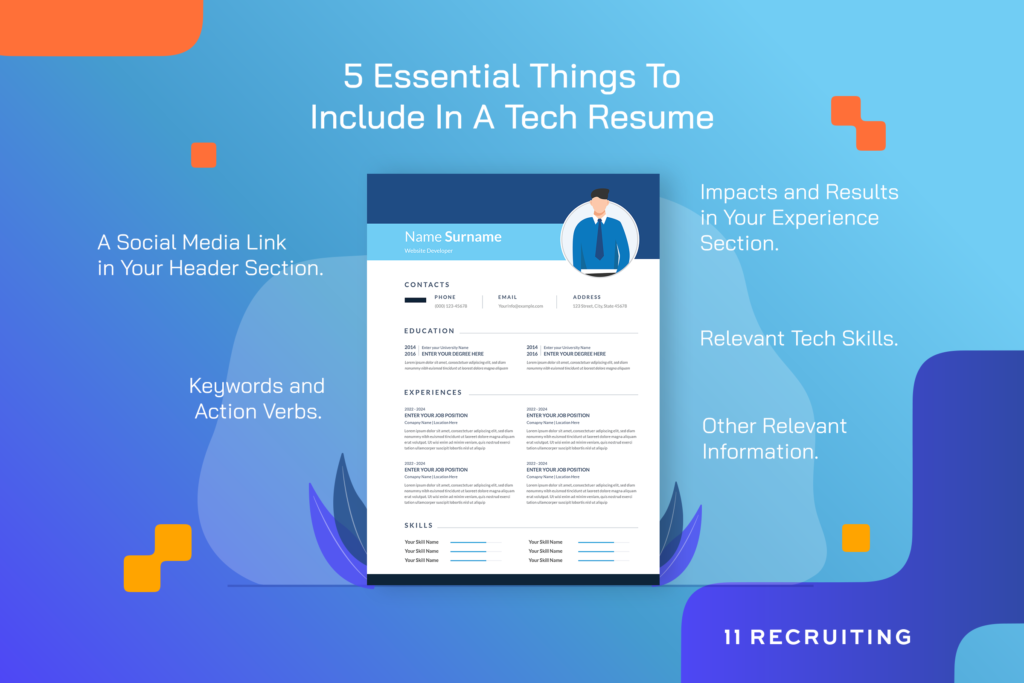
Tech resumes are often essential in the IT industry; without one, it may be difficult to leverage yourself into any tech role. So, if you want to apply for any tech role in the industry, your resume must reflect your skills, experience, and the impact of your work and its result. This article elaborates more on what to include in a tech resume.
5 Essential Things To Include In A Tech Resume

Alongside the typical resume format and requirements, every tech resume has certain perks that soothe any recruiter’s eyes. So, whether you’re a developer, IT consultant, data person, or any other field in the tech industry, your tech resume must contain these things for it to be able to stand out.
1. A Social Media Link in Your Header Section.
A typical resume starts with the Header section that often includes your name, address, and contact details in case the recruiters want to reach out later. Although many people stop here and proceed to the next section, 93% of recruiters like to review any social media profile to check whether they will like you before offering a job. So, if you have any, guide recruiters with the links to your GitHub (for technical positions) and Linkedin (for IT/Managerial positions) profiles by including them on your header, and let them see what you want them to see.
2. Impacts and Results in Your Experience Section.
An excellent way to include your impacts and results in your experience section is by using the XYZ resume format: Accomplished [X] as measured in [Y] by doing [Z]. Start to look at your job role and ask yourself what you did in that role, how you did it, what tools you used and what was the impact or results. With that framework, you’ll be able to develop a compelling bullet point for each task you performed in that role.
Bad example: Grew revenue by mapping new software features for clients’ business goals.
Good example: Grew revenue for 15 small and medium business clients by 10% QoQ by mapping new software features as solutions to their business goals.
For every job title, you should also be able to organize your experience in 2-4 bullets so you don’t overload with so much information that can cause the recruiter to lose interest. 2-4 bullet points are enough for them to know if they’ll hire you.
3. Keywords and Action Verbs.
Most recruiters have little idea of what a job role entails, but they’re aware of the relevant keywords that make it, and they use these keywords to scan resumes. So, you need to know what words are relevant to the tech industry and position and ensure they appear in your resume. Also, using action verbs like integrated, addressed, audited, clarified, strengthened, executed, or developed can help you show ownership of your accomplishments and describe what you did in your role in a more specific and concise way.
Consider using critical terms from the company’s website to demonstrate your understanding of a company and its values. This also means you have to do your homework with research and include in your resume action verbs or language that’s similar to the language the company uses to describe itself to show that you have something in common.
4. Relevant Tech skills.
For your skill section, ensure you include tech skills relevant to the job role’s needs. To make this easier for you, make a list of skills you have, separate them into technical and soft skills and then ask yourself what skills (technical and soft) are most in-demand for the position you are interested in.
One good way to decide what skills to include in your tech resume is to look at job listings for similar positions and note how often a particular skill is listed/repeated. Always lead your skill section with your most vital skills and/or those that seem the most marketable.
5. Other Relevant Information.
Other relevant information may include volunteer experience, extracurricular activities, or interests related to your applying job. And if you can, quantify these experiences, tech competitions, or events with data and results to avoid dismissing this additional information as resume fluff.
For example, say you participated in a tech hackathon where you had to devise a solution for customers. You can put it in your resume under the achievement section as:
Won a blockchain hackathon in 2019 by spotting an error in a corporate BI reporting system which can lead to a 15% increase in processing customer commissions.
This statement demonstrates problem-solving, critical thinking, creativity, attention to detail, and a result-oriented work ethic.
Frequently Asked Questions
What do recruiters want to see in a good tech resume?
More usually than average, recruiters want to know if your technical skills are relevant and up-to-date and if you can use these skills to drive results for a company. They also want an overall view of what prior education or training you’ve put yourself through and a thorough understanding of the value behind your work. And sometimes, recruiters want to know how you explain complex work processes, even to a non-technical person.
What is the recommended layout for a tech resume?
Every tech resume should contain a header section that can grab the recruiter’s attention and facilitates positive expectations. The following section should highlight your experience relevant to the job post and show your ability to impact. Your skill section should follow next with properly prioritizing your technical and soft skills.
The Education and Certification Section should also be included to strengthen your overall working profile, and finally, add a custom section that can either include projects you’ve worked on or your previous achievement to fill gaps in your work history.
What are some technical skills for a sound tech resume?
If you’re working with programming languages, including HTML, CSS, Java, Python, C+, etc. will be a good start. As a DevOps person, consider including docker, Linux, etc. For cloud technologies, it’ll be best to add cloud skills like AWS, Azure, or Google Cloud.
As a developer, consider React.js, Angular.js, Django, Laravel, ASP.NET Core, Ruby on Rails, and Flask. And if you’re into the data field, including SQL or any data language is alright.
What are some quick resume tips for a tech resume?
Use the job description to decide what to include and describe your experiences with relevant action verbs. Make sure to record your accomplishments and contributions, not just your responsibilities. Employers assume that “references will be available upon request,” Also, avoid including personal information about your age, religion, health, or marital status, and most importantly, photos are generally not preferred for U.S. resumes.
What are some suggestions to make a tech resume format stand out positively?
Use a 10-12-point font or larger with a clean, professional-looking font like Times New Roman. Also, use your margins should be at most 0.5 margins on either side and around 1 unit on the top and bottom. Use adequate spacing, and abbreviate your months of employment if you can.
To Sum Up,
Your tech resume has to create a compelling narrative to demonstrate the use of your skills and the impact of your experience instead of simply listing your technical skills and experiences passively. Use the correct format, add relevant social links to guide recruiters’ attention, and make your technical resume easy to read.
Also, use action verbs to provide a context for your skills and prove that you own them. You can also go the extra mile by including any more information you get from researching the companies in your resume.
Are you still confused about how to write your tech resume? Head on to our candidate page so we can put you on the right track.

